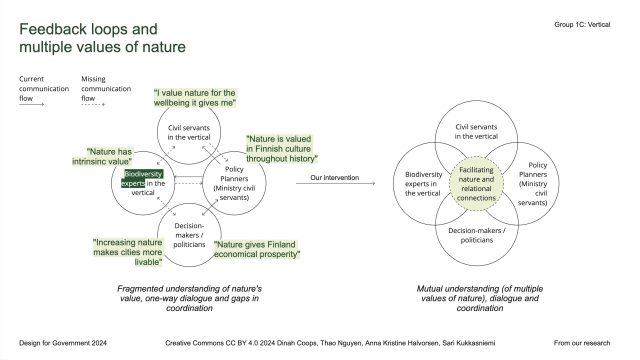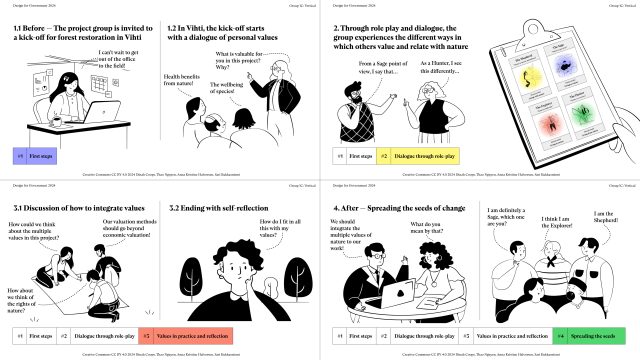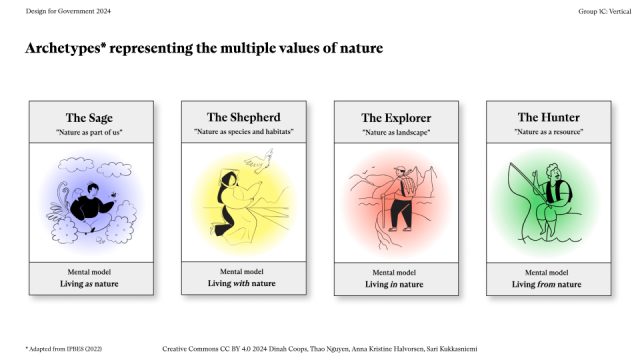This blog post reports on work-in-progress within the DfG course! The post is written by group 1C dealing with the Prime Minister’s Office and Ministry of Environment’s brief on ‘Mainstreaming Biodiversity’. The group includes Dinah Coops and Anna Halvorsen from Creative Sustainability program, Sari Kukkasniemi from Collaborative and Industrial Design program, and Thao Nguyen from International Design Business Management program.
Written by: Thao Nguyen
Wow, it’s been quite a journey to reach this point. We started by planting seeds in the rich soil of biodiversity policy and vertical ecosystems back in January. After nourishing them with desktop and ethnographic research insights for twelve weeks, our seeds have finally grown into seedlings representing the entry point: the multiple values of nature (MVN). Our final proposal proudly introduces the Nature Dialogue (ND) as a project-based approach to understanding the MVN. Our ambition is to facilitate the spread of these beautiful MVN flowers across different sectors through cross-pollination.
Glossary
Nature vs biodiversity: Cambridge Dictionary (2024) defines nature as “all the animals, plants, rocks, etc. in the world and all the features, forces, and processes that happen or exist independently of people” while biodiversity is “the number and types of plants and animals that exist in a particular area or in the world generally”. In this blog, the terms “nature” and “biodiversity” are used interchangeably.
Reflexivity: According to Vink & Koskela-Huotari (2022), reflexivity involves being aware of existing social structures, uncovering hidden frameworks, recognizing structural conflicts, and understanding the potential for structural change.
Multiple values of nature (MVN): According to Secretariat of the Convention on Biological Diversity (n.d.), “biodiversity has multiple values, some can be quantified in monetary terms, and others are more abstract […].” We will discuss the concept more below.
So how did we get here?
Since the previous blog, we have narrowed down the list of twelve entry points (crazy, right?) to the top three and finally selected the chosen one: immersive experiences to foster relationships with nature and between people. This meets the criteria that we wanted to achieve earlier (read more from here). However, it just needs a little… shaping!
Reframing our entry point
According to our desktop research and fieldwork, there is one particular problem that we wish to intervene in the vertical ecosystem: actors in the system have their own viewpoints on nature value(s). We have heard this repeatedly throughout the research. To tackle this issue, our goal is to make the MVN visible by facilitating nature and relational connections.

Figure 1. Facilitating nature and relational connections to understand MVN
Hold on, more research and validation please!
What are the MVN and why are they important?
First of all, biodiversity/nature has multiple values:
“Biodiversity has multiple values, some can be quantified in monetary terms, and others are more abstract. It underpins a wide range of services that support economies, food production systems, secure living conditions, and human health. It is central to many cultures, spiritual beliefs, and worldviews and has intrinsic value.” (Secretariat of the Convention on Biological Diversity, n.d.)
Second, the global biodiversity crisis is closely linked to how nature is valued at all political and economic decision-making levels. Despite the MVN, most policymaking has historically prioritized a limited set of values (IPBES, 2022).
At this point, we knew that tapping into this concept would lead us somewhere, but we were still determining the instrument of change. Based on our research, these two ideas sounded pretty promising:
- An onboarding project-based ritual that embraces face-to-face collaboration on the field, or
- An exchange program to another organization (ministry partner or agency).
But what else?
Validation interviews
To validate our work-in-progress proposal, conducted three validation interviews with experts from the Natural Resources Institute (LUKE), Motiva, and the Ministry of Environment (YM). All experts were optimistic about the direction. From the validation interviews, we learned that the MVN, a well-researched concept, had not been considered in the ministerial decision-making process!
“We had this report (IPBES, 2022), and it was super important and nice, but then we were stuck on what to do with it. We don’t take into account the different values in our decision-making processes” – Senior Specialist, YM.
This is the way! They shed light on the direction of our proposal, guided us through the hidden paths, and led us to the final proposal: the Nature Dialogue.
The Nature Dialogue

Figure 2. The story of nature dialogue
The Nature Dialogue (ND) brings people together to build dialogue around the MVN. As a project-based entry point, it offers opportunities to learn about different viewpoints, create shared understanding, and integrate multiple values in decision-making (Figure 2).
The core idea of ND is based on relational reflexivity which Vink & Koskela-Huotari, (2022) defined as the mode of reflexivity to learn about personal differences through interactions among people. By facilitating joint activities (role-playing) and engaging in interactive scenarios (dialogues), we believe that participants can develop reflexivity regarding personal values related to nature and those of others.

Figure 3. The archetypes that represent the MVN are based on how people conceived of or relate to nature
There are two main elements in our proposal: the archetypes (the tool) and the dialogue (the context). The archetypes: the sage, shepherd, explorer, and hunter. They are used as a metaphor to understand each individual’s viewpoint during role-playing (Figure 3). The dialogue takes place ideally during a project kick-off when relevant members of a project (YM, agencies, other stakeholders, etc.) are gathered in nature. With these, we hope that the combination of both elements can foster reflexivity on nature and other viewpoints. Obviously, the MVN are more than just four archetypes, but we want to start with the most relevant perspective and keep piloting the effectiveness of this approach.
A seedling of values growing into a forest
It will be a bumpy ride to achieve a paradigm shift towards behaviour within the limits of planetary boundaries; however, if we don’t start, we will never know. We fully acknowledge potential barriers that could disrupt the journey of the paradigm shift: volunteer fatigue, political will, external politics, financial pressures, and more. However, we believe that even starting from the most minor action, we can drift away from misunderstanding based on hidden values to understanding based on visible values.
And that’s the Nature Dialogue.
Closing notes
It has been a fulfilling experience with Design for Government. I feel incredibly lucky to be part of this team. I have learned so much from my team members and about myself. Changing the world is not easy, but we just have to trust the process.

References
biodiversity. (2024). In Cambridge Dictionary. Retrieved June 4, 2024, from https://dictionary.cambridge.org/dictionary/english/biodiversity
Intergovernmental Science-Policy Platform on Biodiversity and Ecosystem Services (IPBES). (2022). Summary for policymakers of the methodological assessment of the diverse values and valuation of nature of the Intergovernmental Science-Policy Platform on Biodiversity and Ecosystem Services (IPBES). In Zenodo (CERN European Organization for Nuclear Research). https://doi.org/10.5281/zenodo.6832427
nature. (2024). In Cambridge Dictionary. Retrieved June 4, 2024, from https://dictionary.cambridge.org/dictionary/english/nature
Secretariat of the Convention on Biological Diversity. (n.d.). The Kunming-Montreal Global Biodiversity Framework 2030 Targets: Target 14. Retrieved May 20, 2024, fromhttps://www.cbd.int/gbf/targets/14
Vink, J., & Koskela-Huotari, K. (2022). Building reflexivity using service design methods. Journal of Service Research, 25(3), 371-389
The DfG course runs for 14 weeks each spring – the 2024 course has now started and runs from 26 Feb to 29 May. It’s an advanced studio course in which students work in multidisciplinary teams to address project briefs commissioned by governmental ministries in Finland. The course proceeds through the spring as a series of teaching modules in which various research and design methods are applied to address the project briefs. Blog posts are written by student groups, in which they share news, experiences and insights from within the course activities and their project development. More information here about the DfG 2024 project briefs.

